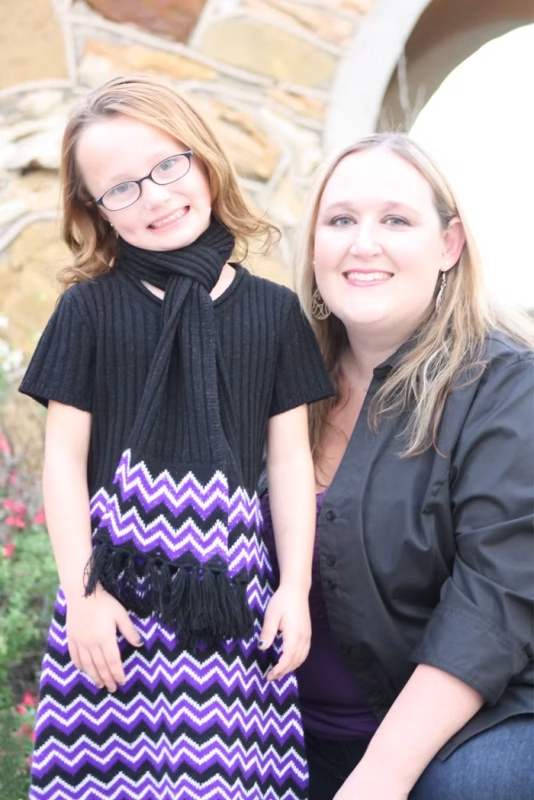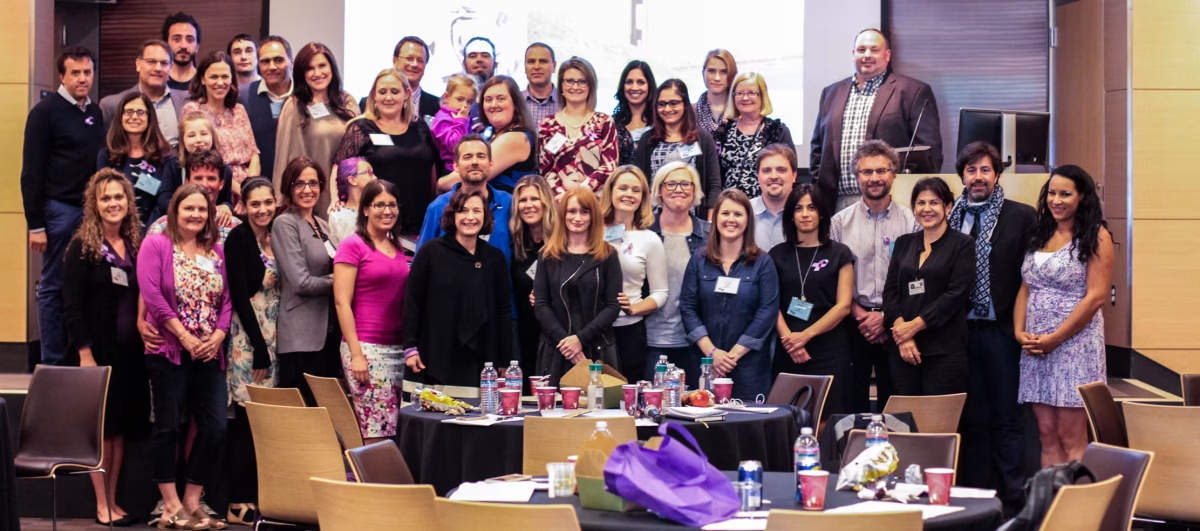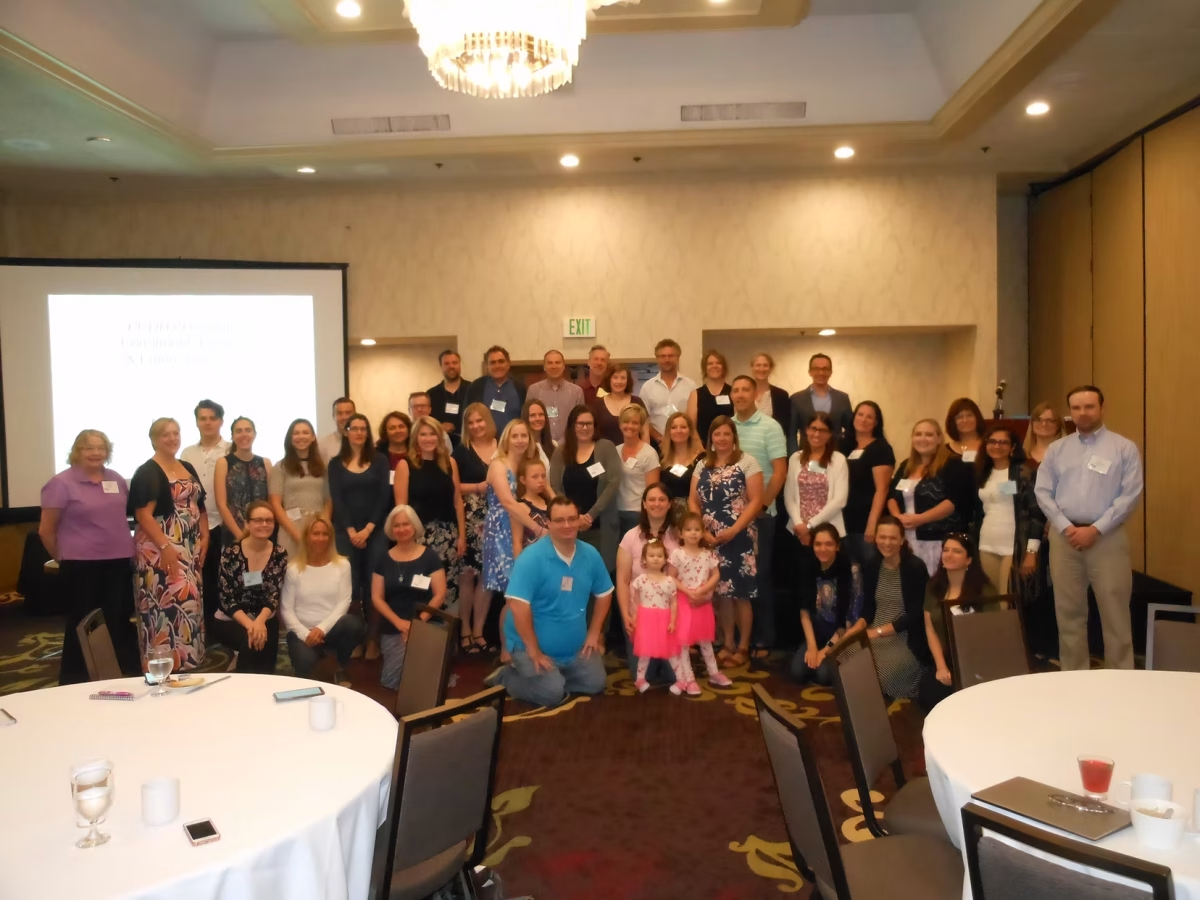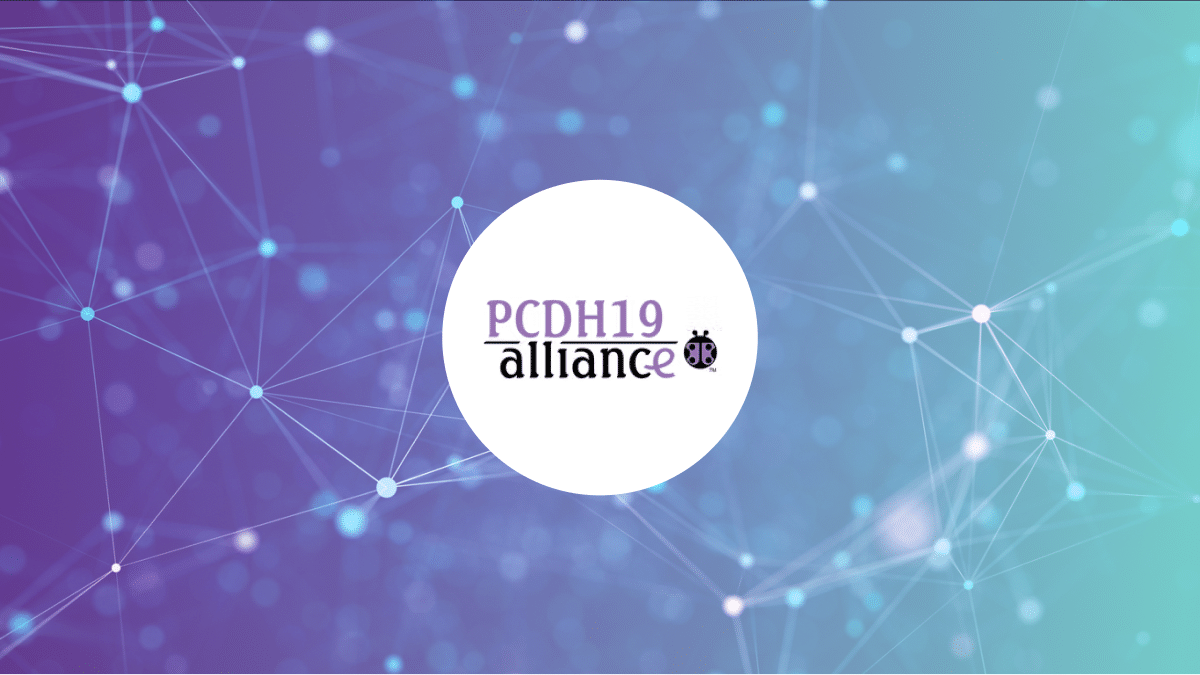Welcome to the 2016 PCDH19 Epilepsy Professional & Family Symposium. We know that not every family facing PCDH19 Epilepsy is able to join us in San Francisco this weekend. The best way to keep up with the conference from afar is to watch the sessions online. The second best way to learn about the newest breakthroughs is to follow along here. I’ll be live blogging and summarizing the points that stick out to me as a parent. I’m not a medical doctor so please don’t consider anything I write to be medical advice but I’ll do my best to keep you updated as the day progresses. Bookmark this page and check back throughout the weekend.
Welcome and Introduction by Joseph E. Sullivan, MD
I am so excited to be sitting here surrounded by families and researchers who are dedicated to getting our kids better. They started the day by showing the video that many of us families contributed to as a way to thank the researchers. We’ll have that up as soon as possible. Keep an eye out for that.
Clinical Update on PCDH19-related Epilepsy and Proposal for a New Classification by Nicola Specchio, MD, PhD
Our girls tend to have focal seizures or “apparently generalized” seizures. He explained that means that the seizure looks like it is generalized but the EEG shows it to be focal. Typically, seizure onset is “stormy”. I’m sure that many of you parents can attest to that. Usually the seizures start during fever and they often continue to be triggered by fevers. This type of epilepsy often has lulls. Girls may stop having seizures for a few years at a time before they come back. We’re not sure if this is a natural part of the disease or if it is related to seizure treatments.
Most of our girls go through 3 – 9 anti-epileptic drugs and they average two medications at a time to work towards seizure control.About half of our girls have behavioral issues. A majority have some cognitive challenges but only about 10% are severely delayed. It seems like the earlier the seizures start, the chance of having behavioral or cognitive issues is higher.
Dr. Specchio has suggested that we reclassify PCDH19 as Fever Induced Cluster Epilepsy (FICE). He explained that name would better explain this disorder. Please feel free to add your thoughts on that change to the comments.
Zebrafish Models of PCDH19: Translating from the Clinic to the Bench by Annapuma Poduri, MD, PhD
Dr. Poduri has to catch a flight to Paris so she will be presenting earlier in the day than planned. She is an MD who treats patients but also conducts research. Her goal is to change the way that we treat our kids’ epilepsy so that we are more effective. She is looking at Zebrafish who have been bread to have this genetic disorder. She said that the fish are genetically about 70% similar to humans which is good for the study but she sees a malformation in their brain. That is important to recognize because people with PCDH19 don’t usually have any brain malformations that show up on their MRI.
I was curious about seizures in fish. Dr. Poduri explained that they watch the way that the fish swim and they look for certain patterns or erratic behavior.
I’ll be honest, I didn’t understand a lot of the science that she shared but I spoke with Dr. Poduri for a moment after she finished. She explained that her research is working towards creating a model that shows how PCDH19 develops and what it looks like on a neurological level. She said that she hopes to use this work to help design treatments specific for this disorder.
How Do PCDH19 Mutations Affect Brain Development? Insights from Mouse Models by Paul Thomas, PhD
Dr. Thomas came all the way from Australia! He said that they have identified over 100 different mutations on the PCDH19 gene that all seem to change the way that the protein works. Losing part of the PCDH19 “code” can cause cells not to group and segregate the way that they should during development. Interestingly, it seems like the mice’s brains look normal but their brain activity is very different. That is similar to what we learned about human brains from Dr. Poduri earlier.
If you have the ability to watch Dr. Thomas’s presentation, I highly recommend it. He is doing an excellent job of explaining the way PCDH19 works in a brain. My understanding is that girls have two copies of their X-chromosome with hundreds of genes on them. During development they randomly silence once of the double genes. Each girl with PCDH19 is unique because it is random which genes will have PCDH19 and which will be missing it. The cells with it and the cells without repel each other instead of binding together like they should. The cells affected include excitatory and inhibitory neurons that are predominantly in the cortical layer of the brain.
Molecular Characterization of PCDH19 in Rat Hippocampal Neurons by Maria Passafaro
PCDH19 is expressed in the synapses of inhibitory and excitatory neurons. Those are the neurons that regulate how much activity there is between the cells. It looks like this gene is important for helping synapses mature in the way they need to. Dr. Passafaro’s research showed that silencing PCDH19 affects GABA transmission.
Paul Thomas, PhD
Dr. Thomas is answering some additional questions. He remarked that PCDH19 is unique even among other relationships. He said ever girl is different because of the randomness of which cells are impacted. This makes it harder to treat because we don’t see a structure that is always abnormal in a specific way, like you might see with other disorders.
Allopregnanolone Deficiency in PCDH19-related Epilepsy: A Case-control Study By Marina Trivisano, MD
Dr. Trivisano is discussing the current theories that attempt to explain the vastly different presentations we see in girls with PCDH19. The first theory is what Dr. Thomas proposed. The second theory is that symptoms may be related to allopregnanalone deficiency. That is an important GABA receptor modulator.
Neurosteroids are used in many existing anti-epileptic medications but they don’t work for everyone. She is currently researching the existence of a biomarker that would help doctors know which patients would be most likely to respond well to a steroid. Her study showed that some girls may have a deficiency in their ability to synthesize neuroactive steroids. She is recommending that girls be evaluated by an endocrinologist that could coordinate with their neurologists.
During the Q & A, they have clarified that sometimes typical steroids are used to combat seizures but neurosteroids are a completely different class of drugs.
Human Pluripotent Stem Cell and Rodent Models of PCDH19 by Jack M. Parent, MD
The research that Dr. Parent does relies on stem cells taken from patients with PCDH19. He uses iPSC which stands for induced pluripotent stem cells which are able to self-renew and can turn into any kind of cell in the organ. It’s amazing to me that he can take cells from someone’s skin or blood and create brain tissue. He learned that if you suspend the neurons they will self-organize into a 3D brain-like structure.
If the gene deletion is too bad, the impacted genes are automatically inactivated so the person does not have symptoms. In his lab, Dr. Parent looked a one person’s cells. The transcription was atypical but he was not sure why. He also saw, like presenters before him described, that the affected neurons and the healthy neurons segregated themselves. They suspect there is a problem with the way the PCDH19 neurons migrate to where they need to end up but they are not sure about that result.
Functional Assessment of PCDH19 Variation: Separating the Wheat from the Chaff by Jozef Gecz, RNDr, PhD
Dr. Gecz is from the University of Adelaide in Australia. His work has formed the basis for many of the studies we have heard about today. He suspects that PCDH19 regulates estrogen receptors. Unfortunately much of the research on the way cells interact with estrogen has been conducted on male animals and it is possible that female cells have different mechanisms.
Dr. Gecz is focusing on determining what variants in PCDH19 are problematic. Every person has quirks in their genes and usually they don’t cause any issues. It is important that we figure out what differences cause epilepsy and which ones are benign so that people can be accurately diagnosed and treated.
A Model for the Study of the Effects of PCDH19 Mosaicism on Brain Circuitry by Gian Michele Ratto
When looking at differences in genes, we have to figure out if the disease is caused by the variance itself or the brain environment that lead to it. When studying genetic disorders, scientist often take healthy neurons and change them so that the gene they are interested in is either missing or broken. Dr. Ratto has been working on a way to more accurately change the DNA that they are studying. This will help them be sure that the researchers are studying what they think they are. This research will help scientists understand how the different genotypes interact and disrupt normal brain activity. It is one important piece of the puzzle that we’re trying to solve.
Saturday Q & A
Joni, a parent, asked a question about the pattern she sees in her daughter. She has really bad behavior that culminates in a seizures and her behavior seems to be reset afterwards. These are preictal patterns that we often called auras. You may notice that they precede your child’s seizures. I like to compare them to rubbing a balloon on your head until your hair stands up. All of that static electricity builds until you finally shock someone. The doctors seem to agree that this pattern exist in PCDH19 and in Dravet but they are not sure why.
I asked Dr. Specchio about the questions some of you asked in the comments. He explained that the seizures may look like tonic-clonics but they always start in one specific space in your child’s brain. The doctors did emphasize that focal seizures can still be very severe and can quickly move to a generalized / tonic-clonic seizure. Also, in reference to the presence of febrile seizures, Dr. Specchio said that at least 70% of the time there are fevers accompanying the seizures and it is up to 100% when you are looking at seizure onset.
The first day of the conference has come to a close. We’ll be back at 9:00 tomorrow.
Good morning and Welcome Back
We are starting the morning by recognizing some very important people. First up is Professor Gecz. He has worked tirelessly to find a cure for PCDH19 and has been an amazing resource to many of us parents. We also want to honor April Haganey. She has tirelessly worked to promote the Alliance, create awareness and raise funds for research. She is the recipient of th 2016 Spirit of Service Award.
Advocating for Your Child Under the IDEA by Mandy G Leigh, JD of Leigh Law Group
Ms. Leigh is an expert in special education law. Remember that all states are different so you’ll want to look into your local options and regulations. She recommends that every parent bring a lawyer or an advocate to their IEP meeting because the schools are often not forthcoming with their resources. The laws are often complex can be difficult for parents to understand.
Most kids with PCDH19 should qualify for an IEP, not just a 504 plan. The difference is that an IEP has goals that the school district is obligated to work towards. If you are in a 504 plan your child may get some accommodations but will not have goals or specialized academic instruction, therapies or behavioral interventions. Both plans have a FAPE provision. That stands for Free and Appropriate Education.
The law requires that the schools provide services that meet your child’s “unique needs.” Many of the PCDH19 kids need different services based on their specific needs. She points out that the court has rejected what they call the “Cadillac Standard.” Basically they don’t have to provide the best, the school must provide the basic accommodations needed to meet their goals. That is why it is so important to develop the right goals.
Ms. Leigh recommends that you avoid using the word best because the school will assume you are asking for Cadillac standards. Instead focus on what is necessary to meet goals.
Your child should be offered the LRE, or least restrictive environment. There is a spectrum of LREs ranging from traditional classrooms all the way to residential treatment facilities. This should be decided by people who understand how your child responds in the classroom and truly know what the best environment may support them most. Ms. Leigh points out that a letter from your doctors reguarding healthcare may be helpful but letters about placement from people who have not seen the child in a school is typically are not well received.
Ms. Leigh’s tips for successful IEPs
- Remember that you are part of the team. You see something that no one else does.
- Know who you can bring to the IEP meeting. You might want to bring your doctor, an expert who knows your child.
- Read the procedural safeguards that your school is required to give you. It is important that you know your rights and give informed consent.
- Ask about touring the facility or observing the classroom that the school is recommending for your child before the meeting. You have a right to observe and understand what you are agreeing to.
- Remember that this meeting is about finding the right thing for your child. The school cannot make one offer and refuse to compromise.
- At the meeting, the school district must bring a person who can sign off on all parts of the IEP, a teacher, and someone who can interpret all test results.
- In California you are allowed to audiotape your meeting so long as you inform them in writing at least 24 hours in advance. Ms. Leigh recommends that you always record so that you have documentation of all changes.
- Share a list of your top 3 – 5 things that you want to discuss and copies of your child’s testing prior to the IEP and share it with the team a few days ahead of time so that they can prepare.
- Ask for your child’s cumulative educational record. You need to know what is being written about your child.
- Keep track of your child’s goals and how they are met over time. Make a folder of notes about what works and what doesn’t for your kid. Don’t be afraid to speak up if they are not making progress towards the goals that you agree on.
PCDH19 Registry Update: Enrollment, Findings and Future Directions by Lacey Smith, MD, CGC and Nilika S. Singhal, MD
Dr Smith and Dr. Singhal have been working hard on the PCDH19 registry. There are currently 33 people who have completed the enrollment process and 15 more who have started it. The registry is open to people who have been diagnosed with PCDH19 and people are carriers but do not have symptoms. If you haven’t already enrolled, you can register here.
The girls in the registry have several types of changes to the DNA. The majority of the girls have at least some developmental delay. There is a wide spectrum of cognitive abilities among the girls. Many have challenges but there is a significant portion that appear typical. Over half of the children were not showing symptoms of Autism but several kids have an ASD diagnosis.
When a child receives genetic testing that shows a variance along PCDH19, her doctors will look to see if other kids with epilepsy have that same variance. That is part of the reason it is so important that everyone who can, join the registry. We want to understand how the different variances affect kids and help others get appropriate diagnoses.
Behavioral Phenotype from the Registry by Christelle Moufawad El Achkar, MD
The registry includes some questions about behavior and many families shared their neuropsychology or psychiatrist’s notes. We can’t make any real conclusions because the data was only on 17 girls. However existing research shows that behavioral challenges, intellectual disability, autism spectrum disorder and global developmental delay are all prevalent among girls with PCDH19.
Of the 17 girls, 10 of them regressed after they started having seizures. Speech seems to be one of the areas that is most affected. They also had motor or social delays and 10 had either intellectual disability or global developmental delay. About one quarter of the girls had some mood problems and more than half had behavioral challenges including ADHD, OCD, aggression and self-harm.
Many of our girls take medications to improve their mood or behavior but we’re not sure which ones are most likely to help. The best option seems to be creating a team that includes your neurologist and behavioral health.
Mental Health Management in Epilepsy: A Collaborative Care Model by Khyati Brahmbhatt, MD
About a third of kids with epilepsy have some type of psychiatric disorder and when the epilepsy is severe that number jumps to at least 50%. Often these kids also struggle with high rates of anxiety which can manifest as behavioral problems. When we look at kids who have mental health problems, we see that 2/3 of them do not receive any treatment and those that do average only three visits with a mental health care provider.
Dr. Brahmbhatt recommends that doctors conduct a quality of life assessment at least annually with kids who have epilepsy. If there are red flags, the family would then complete additional testing to determine what the child is struggling with and would be referred to additional services.
Ideally, you will have a medical home for your child that you can go to for everyday issues and this person will screen for mental health problems. When an issue is detected, they will be able to move you up to appropriate care and they will coordinate so that all of your providers can work together to develop the best response. Dr. Brahmbhatt pointed out how important it is to consider the interaction of physical health and mental health. It is also critical that parents receive support as they deal with their children’s challenges.
In the discussion, a parent asked about behavioral challenges caused by medical trauma. Dr. Brahmbhatt said that it can cause kids to look like they have depression or autistic features. She said that it is hard for researchers to study medical trauma but she understands that multiple hospitalizations can have major impacts on our children.
Another parent asked if there is any research being done on the behaviors that our children exhibit. This has come up in conversation throughout the weekend because so many of us have struggled with the daily life between the seizures. Unfortunately, we were told that no one is looking at PCDH19 behaviors and very few researchers are even looking at epilepsy in general and behaviors. We must work to promote research and awareness of these issues to make life better for our girls and families.
Thank you to all of the researchers, volunteers, families, and supporters for making this weekend amazing.

Le is a counselor, a professor and a mom to three kiddos. Her daughter, Alyssa, is 7 years old and was diagnosed with PCDH19 Epilepsy in November of 2013. She shares her journey on Mom* and would love to connect with you on Facebook.



